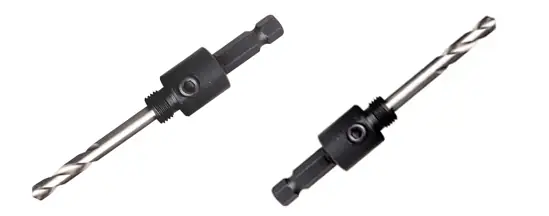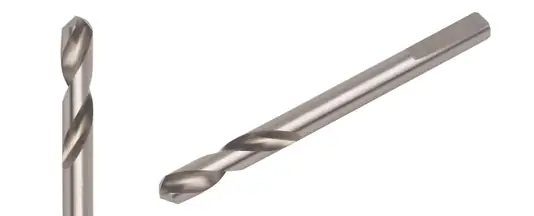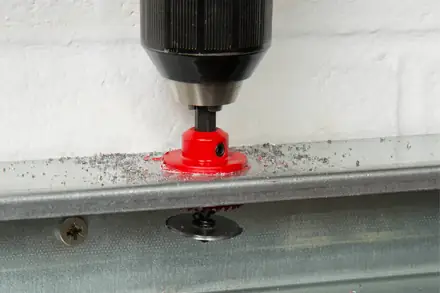When it comes to electrical work, having the right tools can make all the difference. One such tool that finds its utility in various applications is the hole saw. Whether you’re an electrician, a DIY enthusiast, or a professional contractor, understanding hole saws can greatly enhance your efficiency and precision in cutting holes for wiring and other installations. In this blog, we’ll take a closer look at hole saws, exploring their functions, types, components, compatible drills, and proper usage.
What is a Hole Saw?
A hole saw is a circular cutting tool designed to bore holes through a range of materials, including wood, metal, plastic, and even masonry. It’s commonly used in electrical work for creating openings to route wires, install outlets, switches, and junction boxes.
What Does a Hole Saw Do?
Hole saws enable precise and efficient hole creation, often surpassing the capabilities of traditional drill bits. By attaching a hole saw to a drill, you can quickly create holes of various diameters, making it an essential tool for accommodating electrical components securely and neatly.
Different Types of Hole Saws
There are several types of hole saws available, each tailored to specific materials and applications.
Bi-Metal Hole Saws
These hole saws consist of two types of metal – a high-speed steel edge for cutting and a tough alloy backing for strength. They are versatile and can cut through wood, metal, plastic, and more.

Carbide-Tipped Hole Saws
These hole saws are designed for cutting through hard materials like ceramics, tiles, and masonry. The carbide teeth provide exceptional durability and precision.
Diamond-Coated Hole Saws
Ideal for extremely hard materials like glass, ceramic tiles, and stone, these hole saws have a diamond-coated edge for superior cutting performance.

Adjustable Hole Saws
These versatile hole saws have an adjustable mechanism that allows you to change the hole’s diameter, providing flexibility for different needs.
Different Parts of a Hole Saw
A hole saw consists of several essential components.
Arbor
The Arbor is the central shaft that connects the hole saw to the drill. It holds the hole saw securely in place during cutting.

Pilot Bit
This small bit at the centre of the hole saw guides the cutting process and helps create a clean hole.

Cutter
The cutter is the outer edge of the hole saw that does the actual cutting. Its design varies based on the material it’s intended to cut.

How to Choose a Hole Saw?
Selecting the right hole saw involves considering the material you’re cutting and the desired hole diameter. Choose a hole saw that matches the diameter of the hole you need and ensure that it’s designed for the material you’re working with.
This set offers a variety of sizes at a great price.

What Kind of Drill Do You Need for a Hole Saw?
A drill with a chuck that can accommodate the Arbor of the hole saw is required. Corded or cordless drills can work but ensure that the drill’s speed settings are compatible with the hole saw’s cutting speed recommendations.
How to Use a Hole Saw?
Mark the Spot: Use a pencil or marker to indicate where you want the hole to be.
Secure the Material: Clamp the material down securely to prevent movement during the cutting process.
Attach the Hole Saw: Insert the hole saw’s Arbor into the drill’s chuck and tighten it securely.
Begin Cutting: Start the drill at a low speed and allow the pilot bit to make initial contact with the material. Once the pilot bit has created a groove, increase the speed gradually.
Apply Steady Pressure: Apply steady, even pressure while allowing the hole saw’s teeth to do the cutting. Avoid pushing too hard, as this can lead to overheating and reduced cutting efficiency.
Clear Debris: Occasionally stop the drill to clear away debris from the hole and the pilot bit.
Complete the Hole: Continue cutting until the hole saw has penetrated completely through the material.
Remove the Hole Saw: Slowly release the trigger on the drill and wait for the hole saw to stop spinning before removing it from the material.
By following these steps, you can ensure safe and precise hole cutting with a hole saw, making your electrical installations smoother and more professional.
In conclusion, hole saws are invaluable tools for electrical work, allowing you to create clean and accurate holes in various materials. By understanding the different types, components, and usage techniques, you can enhance your efficiency and achieve better results in your electrical projects. Whether you’re a seasoned professional or a DIY enthusiast, having a quality hole saw in your toolkit can make a world of difference.

